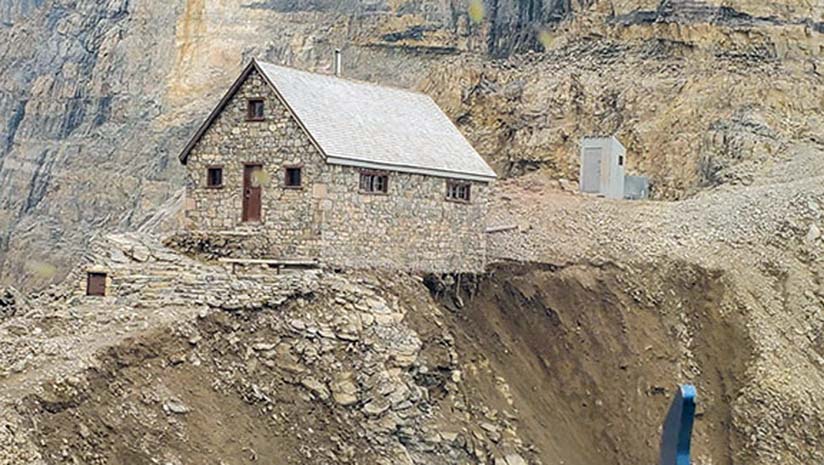
Banff Alberta - A national historic site in Banff National Park that was built 100-years-ago will be taken apart this spring because of
climate change.
The Abbot Pass Refuge Cabin, constructed in 1922 by Swiss mountain guides, stood up against snowstorms and gale force winds, but officials say the slope below
the structure is collapsing.
Parks Canada said in a release that as a result of the structural damage to the hut, it will be dismantled this spring out of a concern for public
safety.
Officials blamed climate change for the need to remove the popular historic site.
"Parks Canada recognizes the importance of the Abbot Pass Hut to many Canadians, particularly those in the climbing and alpine community, and is saddened
by the loss of this treasured alpine refuge due to the effects of climate change," the agency wrote in a release.
The hut's location on a steep slope, along with high temperatures in summer 2021, likely contributed to further erosion, deterioriating the rock and
ice.
The Alpine Club of Canada, the organization that operated the hut for more than 35 years, said the decision was "difficult."
"We offer special thanks to our community and to everyone who has been a guest at the hut since 1985," the group wrote on Facebook.
"Parks Canada remains committed to conservation, and to taking action to better understand and mitigate the impacts of climate change on Canada's natural
and cultural heritage."
Problems Discovered in 2016
Parks Canada says it was first notified about issues involving the hut in 2016, when there were reports of rockfalls and significant erosion.
Work was conducted to study the slope and determine its stability, and in 2018 crews performed necessary stabilization operations, including the installation
of rock anchors.
However, new assessments last year discovered even more problems.
"Geotechnical assessments conducted in 2021 found higher levels of slope erosion, and new evidence including cracks in the masonry, that reveal the entire
hut has been impacted," Parks Canada said.
"Unfortunately, the work also revealed that the hut itself would not be able to be transported or even deconstructed in "a way that would allow for
the hut to be rebuilt, either at Abbot Pass or at another location."
That's primarily because the location is too unstable to perform such a task while maintaining the health and safety of Parks Canada crews, officials
said.
The limestone used to build the hut is also very "likely to fracture if moved."

Consultations Underway
The hut, hand-built using materials that were locally acquired, and carried to the 2,925-metre (9,598-foot) pass either on horseback or on foot, has a
significant historical importance, the agency said.
While the building itself cannot be saved, Parks Canada says work is underway to preserve its heritage for future generations.
"Consultations with indigenous groups, the Alpine Club of Canada, stakeholders, and the public are planned for 2022 to help identify options for
continuing to commemorate the story of the Abbot Pass Hut and its importance to the history of architecture and mountaineering in Canada," officials
said.
Parks Canada also says plans are underway to "salvage some material from the hut" for use in a potential future memorial.
Timeline of the Abbot Pass Refuge Cabin (courtesy Parks Canada):
1922: Abbot Pass Refuge Cabin (Abbot Pass Hut) constructed.
1968: Dominion Parks Branch (known today as Parks Canada) acquires the hut.
1973: Abbot Pass Refuge Cabin is restored.
1985: Alpine Club of Canada assumes operation of the hut.
1992: Abbot Pass Refuge Cabin is designated as a national historic site.
2012: Parks Canada completes roof and drainage upgrades.
2014: Parks Canada completes stone masonry restoration.
2016: Initial slope instability reported to Parks Canada.
2017: Slope stability geotechnical assessment begins.
2018: Hut closed and initial slope stability work conducted to install rock anchors below the hut.
2019: Additional slope stability work not completed due to unfavourable weather conditions causing safety concerns at the site.
2020: COVID-19 health measures prevent additional slope stability work from being completed.
2021: Further slope erosion occurs, impacting the base of the hut.
Area closure expanded to include Abbot Pass and its two approach routes.
Second geotechnical assessment conducted.
Heritage recording completed.
2022 (anticipated): Abbot Pass Hut removed.
Michael Franklin.
(there was no image with original article)
(usually because it's been seen before)
provisions in Section 29 of the Canadian
Copyright Modernization Act.

